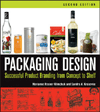Clamshell Design Dispenses Convenient Thermal Packs

To grow in today’s competitive marketplace, brand managers must constantly seek new ways to expand their brands into adjacent categories. But pursing this approach can be a difficult and risky task.
Without the firm foundation of a strategic pre-design exercise, the brand extension could actually do more harm than good. Consumers are quick to spot when trusted brands transform into ill-fitting “badges” that lack the core values and established merits.
Packaging performs not only as the “product salesman” at retail, but sets the tone and position for the product’s everyday use. In doing so, it creates an emotional bond between the product and user, reinforcing the personality of the brand on a higher level as it transitions to a broader market.
Brand managers who fully understand this have been able to transpose some of today’s most successful brands and venture beyond the categories where they are most synonymous.
Our “blue-sky” packaging concept this month addresses how a sporting goods manufacturer can extend a pain-relief technology to a broader audience by considering aesthetic and consumer needs.
Handy Relief For Tired Muscles
Chemical hot and cold packs are widely used by doctors, sports coaches and consumers to treat muscle injuries. The mixing of water and a chemical compound generates an endothermic reaction within a sealed pouch. This thermal pack provides fast relief without the need for external heat or ice and cool boxes.
As the recreational sport and exercise markets advance, the principles behind these products could embody handy hot or cool packs.
Consumer acceptance of this idea mandates novel packaging that delivers a new level of convenience and supportive imagery. One way to achieve this is to make the primary package function as a delivery system.
The accompanying illustration shows a simple transparent, plastic clamshell with a molded end cap. It provides an opening slot for the easy removal of the pouches.
The act of pulling out each pouch ruptures a seal between two internal chambers and distributes a film of water across the chemical compound. This activates the cooling or heating effect.
The tab of the next pouch automatically indexes into the opening. A numeral on each pouch tells the number of treatments remaining. (Those readers who are old enough to remember the Polaroid cameras of the 1970s will realize where we got our inspiration for this configuration and simple linear delivery method.)
The author, Rob Croft, is Managing Partner of Swerve Inc., specialists in 3-D brand design.
Contact him at 212.742.9560 or rob@swerveinc.com
Looking for a reprint of this article?
From high-res PDFs to custom plaques, order your copy today!







